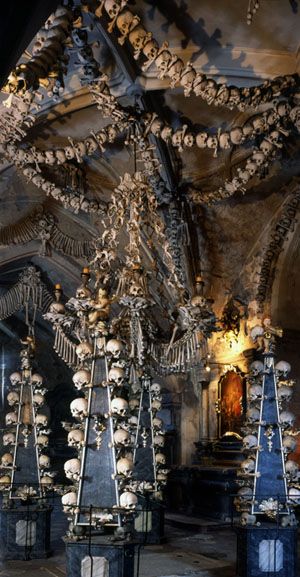Wondrous travels
The Czech Republic offers new concepts of death and living space
They say that the joy of knowledge is in being surprised by something, rather than by remembering something. Quite a few people deviate from the textbook tourist itineraries and places of interest. Travel+Leisure reads that Times Square, NYC, was last year’s biggest tourist attraction, visited by over 39 million tourists.
Each country is supposed to have special tourist attractions. This depends on that country’s capacities and the local travel agencies’ creative potential. The Czech Republic boasts gorgeous European architecture, history, enjoyable entertainment programs, and at least two cities that can really impress the tourist, making him/her ask the guide a dozen of questions.
Kutna Hora is a typical town located in the central part of Bohemia, yet it is one the country’s historic places (among other things, owing to its silver mines that gained importance during the economic boom of the 13th century, along with its beautiful architecture, including the enchanting Gothic structure of St. Barbara’s Cathedral). There is, however, a small Roman Catholic chapel known as the Sedlec Ossuary. Its decorations and furnishings are believed to have been made using the skeletons of between 40,000 and 70,000 people.
How did this chapel come to be? Back in 1278, King Otakar II of Bohemia sent Henry, the abbot of the Cistercian monastery in Sedlec, to Palestine [also known as the Holy Land]. He returned with a small amount of earth he had removed from Golgotha (where Jesus Christ had been crucified, according to the New Testament) and sprinkled it over the abbey cemetery. From then on the grounds were considered to be holy and the cemetery in Sedlec [i.e., Kutna Hora] became a desirable burial site throughout Central Europe. Then there was the plague epidemic (Black Death) in the 16th century that added fuel to the fire of this belief, followed by the pitched Catholic-Protestant religious battles. The burial grounds kept expanding. Sometime in 1400, a Gothic church was built in the center of the cemetery, with a vaulted upper level and a lower chapel to be used as ossuary for the mass graves unearthed during construction – in other words, slated for demolition to make room for new burials. Four hundred years later, the House of Schwarzenberg (some of the men of this family are still representing the Czech Republic on the international arena) said they wanted to buy the church and the grounds. They did and hired Frantisek Rint, a noted Czech woodcarver, tasking him with putting the heaps of bones into order and improving the grounds. The result was macabre, yet this is precisely what makes the place a major tourist attraction.
In fact, what you feel first when stepping into the Sedlec Ossuary isn’t fear; it is like seeing the setting of another Indiana Jones or Pirates of the Caribbean movie. The place looks impressive, exotic, making the visitor reconsider the concept of death; it does not look frightening, in broad daylight anyway.
Brno is another tourist attraction. This is the Czech Republic’s industrial center and it boasts the functionalist Villa Tugendhat (included in the UNESCO List of World Heritage Sites). At first sight, this structure looks like another suburban project, with its design reminding one of social realism. A UNESCO commission found it to be one of the best living spaces. You can ask your guide why.
When visiting the place, you may be puzzled at first to observe the rectangular shape, the absence of external decorations, the presence of some modest dwellings. A closer look shows that the whole design is well thought out to make the residents comfortable, including a home elevator built at the start of the 19th century. The villa was designed by the German architect, Ludwig Mies van der Rohe, and was first owned by Fritz Tugendhat and his wife Greta, a Jewish-German family of textile industrialists. The family lived there in 1930-38, then left for Switzerland, on the eve of WW II, and later settled in Venezuela.
Greta Tugendhat wrote later that the villa’s huge inner space made her feel free and peaceful, something one can never feel in any “closed” room. To create this sensation of space and light, the architect used a steel frame design that allowed to do without the additional support walls. Open terraces and floor-to-ceiling windows facing the garden add a special charming touch to the design. One of the innovative approaches was a device on the second story that allowed to electrically lift the windows. In 1950-79, Villa Tugendhat was used as a therapeutic exercise facility. Small wonder, considering the expert findings to the effect that the structure is an innovative architectural design, being integrated with the environs. Since 1994, the villa has served as a museum.
Those eager to travel and receive fresh tourist experiences should visit the Czech Republic with its Villa Tugendhat, Sedlec Ossuary, and other places of interest.
Viktoria Skuba, The Day’s journalist, made the trip to the Czech Republic assisted by CzechTourism office in Ukraine






